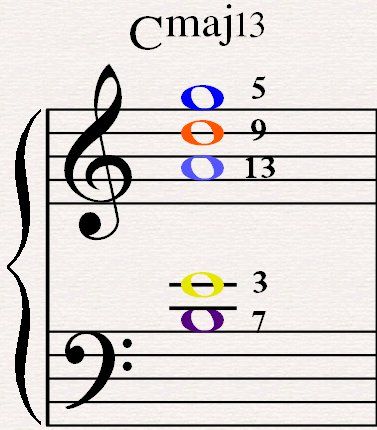Now, in Part 2, each voicing will be colorfully broken down.
Color-Coding Chord Tones
 |
| C major scale, in colors. |
*Please note that the people I attribute the following voicings to (and therefore the labels I assign each one), are by no means the originators of a particular voicing. Rather, they are the musicians/educators from whom I personally learned each voicing. (I will link to the relevant sources as we go along.)
Five Colorful Voicings
- Symmetry in intervals: 3rd, 4th, 4th, 4th, 3rd
- Very similar to the next voicing (Tristano), but more colorful because it contains the 7th
- LH contains a minor chord in first inversion, RH contains a major chord in second inversion

2) "Tristano" Cmaj6/9 (a la Lennie Tristano)
- Top four notes are spaced out by a 4th
- Root is doubled, appearing on the very bottom and top of the voicing
- Tristano often used this by "planing" this shape, moving it up or down chromatically
3) Rootless "A Position" Quartal Voicing, Cmaj6/9 (via Earl MacDonald)
- 3rd on bottom (root on top)
- Basically the same as Tristano's voicing, but without the root doubled in the LH
4) "B Position" Quartal Voicing, Cmaj13 (via Earl Macdonald)
- 7th on bottom (5th on top)
- Rootless
5) "Drop 2" Cmaj9
- Notes are not as evenly-spaced in this one (not as quartal as the others)
- The B (the 7th) was lowered by an octave
- To learn how to construct any voicing using the Drop 2 technique, click here.
Final Remarks
What to do with all of this information? If you happen to latch on to the sound/feel of one or two of these, take a second to figure it out on the piano. Divide the notes between hands however is most comfortable to you (in some 5-note cases, it may be preferable to put three notes in the LH, two in the RH, but you might prefer it the other way around). From there, continue around the Cycle of Fourths (or Fifths), constructing the voicing slowly and carefully.
Happy voicing!





No comments:
Post a Comment